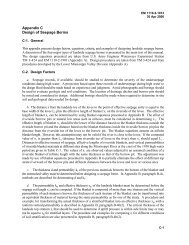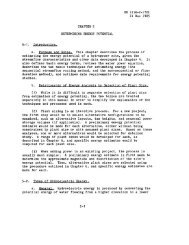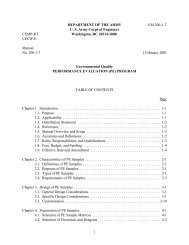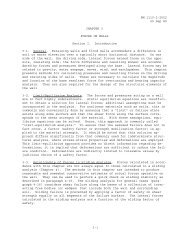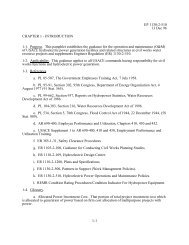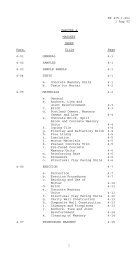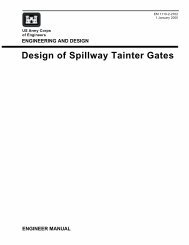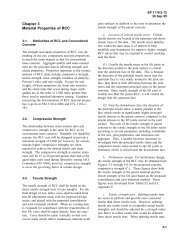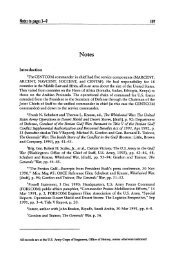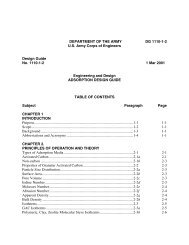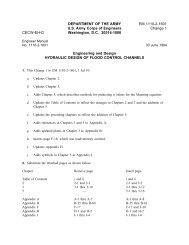Earthquake Design and Evaluation of Concrete Hydraulic Structures
Earthquake Design and Evaluation of Concrete Hydraulic Structures
Earthquake Design and Evaluation of Concrete Hydraulic Structures
You also want an ePaper? Increase the reach of your titles
YUMPU automatically turns print PDFs into web optimized ePapers that Google loves.
EM 1110-2-6053<br />
1 May 2007<br />
with fundamental periods <strong>of</strong> vibrations between 0.75 T0 <strong>and</strong> 1.5 T0, can be estimated using<br />
equal energy principles. The inelastic response <strong>of</strong> structures with fundamental periods <strong>of</strong><br />
vibration greater than 1.5 T0, can be estimated using equal displacement principles.<br />
(1) Equal acceleration response. Rigid structures, with a period <strong>of</strong> vibration (T) equal or less<br />
than 0.04 sec (or between 0 <strong>and</strong> 0.75 T0), will exhibit an equal acceleration response. In this<br />
case, force or acceleration is conserved regardless <strong>of</strong> any ductile properties attributed to the<br />
structure. <strong>Structures</strong> exhibiting an equal force or acceleration response should therefore be<br />
designed to remain elastic.<br />
Spectral Acceleration (in/sec2)<br />
700<br />
600<br />
500<br />
400<br />
300<br />
200<br />
100<br />
A<br />
B C<br />
T=0.5 sec<br />
0<br />
0 5 10<br />
Spectral Displacement (in)<br />
<strong>Earthquake</strong> Dem<strong>and</strong><br />
(Response Spectrum Curve)<br />
T=1 sec<br />
Capacity (Load-displacement) Curve<br />
Figure 3-1. <strong>Earthquake</strong> Dem<strong>and</strong>s on Inelastic <strong>Structures</strong><br />
(2) Equal energy response. <strong>Structures</strong> with fundamental periods <strong>of</strong> vibration between 0.75<br />
T0 <strong>and</strong> 1.5 T0 will exhibit an equal energy response. The characteristic ground motion period<br />
(T0) generally varies between 0.2 seconds <strong>and</strong> 0.7 seconds depending on site conditions, with<br />
firm sites having shorter characteristic periods than s<strong>of</strong>t sites. The structure must have sufficient<br />
displacement ductility to provide the reserve inelastic energy capacity needed to resist<br />
earthquake ground motion dem<strong>and</strong>s. The equal energy response concept is presented in<br />
Figure 3-2. For a given displacement ductility (μδ), the inelastic (yield) capacity (FY) must be<br />
sufficient to produce an equal energy response. Equating the energy for a linear elastic<br />
response to that for an inelastic response (hatched area under the nonlinear portion <strong>of</strong> the load<br />
displacement curve equal to the hatched area under the linear elastic curve), it can be<br />
determined that the yield capacity <strong>of</strong> the structure must be equal to or greater than the capacity<br />
required <strong>of</strong> the structure if it were to remain elastic (FE) divided by 2μδ−1, or:<br />
3-6<br />
FE<br />
F Y ≥<br />
(3-4)<br />
2μ −1<br />
δ<br />
15




